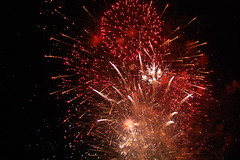Today we celebrate Australia Day, the day in 1788 when Captain Phillip and the First Fleet arrived in Sydney Harbour from nearby Botany Bay. More history is below (below the line) for those who want more details. And to celebrate that arrival, Australian people will have already eaten barbecued breakfasts and lunches, gathered at the beaches, kicked footballs and smashed cricket bats against balls, and celebrated the landing these 223 years later.
To add to that, the celebrations at the Harbour tonight with fireworks, and in fact, all across the country from the Yarra to the Swan, will be met with tens of thousands of co-celebrants. We love to toast the country and the opportunities.
Of course, some Australians, most notably the native Aborigines, don't celebrate today in the same way. For them this is Invasion Day when they lost their footing and standing in so many ways.
One man's trash is another man's treasure. Some see the glass half-empty; for others it's half-full. You get it...there's a lot of variety out there and different views of the same reality.
Yet into the midst of that variety came the Absolute Truth. He alone is the One who arrived, 2000 years ago and declared himself to be The One. Wow, what chutzpah!
Some today now celebrate the One who died for our sins and rose from the dead.
Some today dismiss Y'shua as irrelevant.
And some will aver that one man's view of Y'shua (some call him by the English name "Jesus") is just as accurate and right as any other view. But that relativism is not on.
Who He is matters. What we believe about Him doesn't change who he is. However, it will change our perspective on life. And our life in its entirety.
And that's something to celebrate for the next 223 years and eternity!
__________________
The first records of European mariners sailing into 'Australian' waters occurs around 1606, and includes their observations of the land known as Terra Australis Incognita (unknown southern land). The first ship and crew to chart the Australian coast and meet with Aboriginal people was the Duyfken captained by Dutchman, Willem Janszoon.
Between 1606 and 1770, an estimated 54 European ships from a range of nations made contact. Many of these were merchant ships from the Dutch East Indies Company and included the ships of Abel Tasman. Tasman charted parts of the north, west and south coasts of Australia which was then known as New Holland.
In 1770, Englishman Lieutenant James Cook charted the Australian east coast in his ship HM Barque Endeavour. Cook claimed the east coast under instruction from King George III of England on 22 August 1770 at Possession Island, naming eastern Australia 'New South Wales'. The coast of Australia, featuring Tasmania as a separate island, was mapped in detail by the English mariners and navigators Bass and Flinders, and the French mariner, Baudin. A nearly completed map of the coastline was published by Flinders in 1814.
This period of European exploration is reflected in the names of landmarks such as the Torres Strait, Arnhem Land, Dampier Sound, Tasmania, the Furneaux Islands, Cape Frecinyet and La Perouse. French expeditions between 1790 and the 1830s, led by D'Entrecasteaux, Baudin, and Furneaux, were recorded by the naturalists Labillardière and Péron.
Captain Arthur Phillip and the First Fleet, comprising 11 ships and around 1,350 people, arrived at Botany Bay between 18 and 20 January 1788. However, this area was deemed to be unsuitable for settlement and they moved north to Port Jackson on 26 January 1788, landing at Camp Cove, known as 'cadi' to the Cadigal people.
Governor Phillip carried instructions to establish the first British Colony in Australia. The First Fleet was under prepared for the task, and the soil around Sydney Cove was poor. The young colony relied upon both the development of farms around Parramatta, 25 kilometres upstream to the west, and also trading food with local Aboriginal clans.
The Second Fleet's arrival in 1790 provided badly needed food and supplies; however the newly arrived convicts were too ill, with many near to death, to be useful to the colony. The Second Fleet became known as the 'Death Fleet' - 278 of the convicts and crew died on the voyage to Australia, compared to only 48 on the First Fleet.
The colony experienced many other difficulties, including the fact that there were many more men than women - around four men for every woman - which caused problems in the settlement for many years.
I invite interested bloggers and enquirers to interact with the messages. Shalom!
26 January 2011
Subscribe to:
Post Comments (Atom)
If I could speak..... with Sarah Silverman
Another blog of a ‘what if’ variety Over the years, I’ve seen a celebrity in sport or literature or movies/television and wondered aloud w...

-
The question is asked in the Good Book, "How shall a man keep his way pure?" I wonder if that's a question that's beyond n...
-
Driving past the houses in a wealthy suburb of Chicago, on our way to visit a church there, we saw mansion after mansion and thought to ours...
-
A sermon given in Sydney Earlwood Indonesian Presbyterian Church Introduction Shalom Pastor Gunung and all here at Earlwood church. Salamat ...




No comments:
Post a Comment